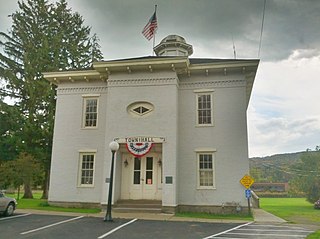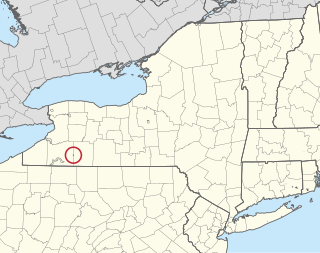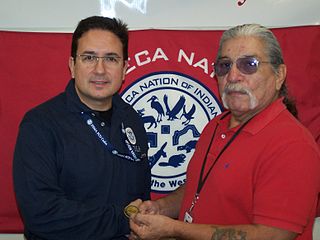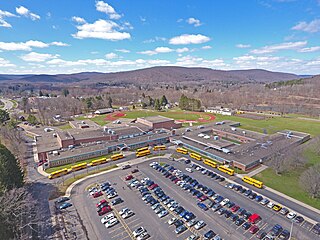Related Research Articles

Allegany County is a county in the U.S. state of New York. As of the 2020 census, the population was 46,456. Its county seat is Belmont. Its name derives from a Lenape word, applied by European-American settlers of Western New York State to a trail that followed the Allegheny River; they also named the county after this. The county is part of the Western New York region of the state.

Cattaraugus County is a county in Western New York, with one side bordering Pennsylvania. As of the United States 2020 census, the population was 77,042. The county seat is Little Valley. The county was created in 1808 and later organized in 1817. The county is part of the Western New York region of the state.
Coldspring is a town in Cattaraugus County, New York, United States. As of the 2020 census it had a population of 661. It is located in the southwest part of the county, west of the city of Salamanca.
Red House is a town in Cattaraugus County, New York, United States. As of the 2020 census, the town population was 30, making it the least populous town in the state. The town is on the south edge of Cattaraugus County, south of the city of Salamanca.

Allegany Reservation is a Seneca Nation of Indians reservation in Cattaraugus County, New York, U.S. In the 2000 census, 58 percent of the population within the reservation boundaries were Native Americans. Some 42% were European Americans; they occupy properties under leases from the Seneca Nation, a federally recognized tribe. The population outside of the rented towns was 1,020 at the 2010 census. The reservation's Native American residents are primarily members of the Seneca, but a smaller number of Cayuga, another Iroquois nation, also reside there, and at least one family is known to have descended from the Neutral Nation. Prior to the 17th century, this area was occupied by the Iroquoian-speaking Wenrohronon and Eriehronon. The more powerful Seneca eliminated these competing groups during the Beaver Wars beginning in 1638, as the Iroquois Confederacy sought to control the lucrative fur trade with the French and Dutch colonists.

Oil Springs Reservation or Oil Spring Reservation is an Indian reservation of the federally recognized Seneca Nation that is located in southwestern New York, United States. As of the 2010 census, the Indian reservation had one resident; in 2005 no tribal members had lived on the property. The reservation covers about one square mile (2.6 km2), divided between the present-day counties of Allegany and Cattaraugus. The reservation is northwest of the village of Cuba. It is bordered by the Town of Cuba and the Town of Ischua.
Salamanca is a town in Cattaraugus County, New York, United States. The population was 470 at the 2020 census. The name is from José de Salamanca y Mayol, Marquis of Salamanca, a major Spanish investor in the Atlantic and Great Western Railroad, a local railroad.
Salamanca is a city in Cattaraugus County, New York, United States, inside the Allegany Indian Reservation, one of two governed by the Seneca Nation of New York. The population was 5,929 at the 2020 census. It was named after José de Salamanca, a Spanish nobleman and cabinet minister of the mid-19th century. Salamanca invested in railroads around the globe, including the Atlantic and Great Western Railroad in New York State, Pennsylvania, and Ohio.
There are four treaties of Buffalo Creek, named for the Buffalo River in New York. The Second Treaty of Buffalo Creek, also known as the Treaty with the New York Indians, 1838, was signed on January 15, 1838 between the Seneca Nation, Mohawk nation, Cayuga nation, Oneida Indian Nation, Onondaga (tribe), Tuscarora (tribe) and the United States. It covered land sales of tribal reservations under the U.S. Indian Removal program, by which they planned to move most eastern tribes to Kansas Territory west of the Mississippi River.
The Tonawanda Seneca Nation is a federally recognized tribe in the State of New York. They have maintained the traditional form of government led by sachems selected by clan mothers. The Seneca are one of the original Five Nations of the Haudenosaunee or Iroquois Confederacy. Their people speak the Seneca language, an Iroquoian language.
Irving is a hamlet in Chautauqua County, New York, United States. It is located near the eastern town line and the eastern county line in the town of Hanover. U.S. Route 20 and New York State Route 5 pass through the hamlet, which is next to Cattaraugus Creek; New York State Route 438 terminates just across the creek. The elevation of the hamlet is 584 feet (178 m) above sea level. The ZIP Code for Irving is 14081.
Steamburg is a hamlet in the Town of Coldspring in Cattaraugus County, in western New York, United States.

The Seneca Nation of Indians is a federally recognized Seneca tribe based in western New York. They are one of three federally recognized Seneca entities in the United States, the others being the Tonawanda Band of Seneca and the Seneca-Cayuga Nation of Oklahoma. Some Seneca also live with other Iroquois peoples on the Six Nations of the Grand River in Ontario.
Jimerson Town is a native planned community on the Allegany Indian Reservation within the bounds of Cattaraugus County, New York. Along with Irving on the Cattaraugus Reservation, Jimerson Town is one of two capitals of the Seneca Nation of Indians.
Elko was a town in Cattaraugus County, New York that existed from 1890 to 1965. It was forcibly evacuated in 1965 due to the construction of the Kinzua Dam on the Allegheny River in Warren County, Pennsylvania, one of the largest dams in the United States east of the Mississippi. The dam was authorized by the United States Congress as a flood control measure in the Flood Control Acts of 1936 and 1938, and was built by the U. S. Army Corps of Engineers beginning in 1960. Other benefits from the dam include drought control, hydroelectric power production, and recreation.
The Third Treaty of Buffalo Creek or Treaty with the Seneca of 1842 signed by the U.S. and the Seneca Nation modified the Second Treaty of Buffalo Creek. This reflected that the Ogden Company had purchased only two of the four Seneca reservations, the Buffalo Creek and Tonawanda reservations, that the Senecas had agreed to sell in the Second Treaty; it thus restored native title to the Allegany, Cattaraugus and Oil Springs reservations.
Kill Buck is a hamlet in Cattaraugus County, New York, United States. The community is located along New York State Route 417 and U.S. Route 219 Business, sharing its western border with the eastern border of the city of Salamanca. Kill Buck is named after Daniel Kill Buck, who was a mayor of the community during its days as a Seneca village.

Salamanca City Central School District is a New York state public school district that serves the city of Salamanca, NY and surrounding communities. It consists of three schools for students grades Pre-Kindergarten through 12: Prospect Elementary School, Seneca Intermediate School, and Salamanca High School. Seneca Intermediate and Salamanca High share the same building at 50 Iroquois Drive in the city.
Phyllis Eileen Williams Bardeau (Gayanögwad) was a Seneca author, and educator, and lexicographer. She was best known for her work on the Seneca language, including Seneca language dictionaries.
References
- ↑ Jack Campisi and William A. Starna. "Iroquois Journey: An Anthropologist Remembers by William N. Fenton: Introduction" (PDF). Nebraska Press. p. 8. Archived from the original (PDF) on 5 July 2010. Retrieved 23 August 2010.
- ↑ "Maxine F. Dowler Obituary (2015) Olean Times Herald". Legacy.com. Retrieved 2022-07-01.
- ↑ "Maxine F. Dowler is the current Vice-President of the BOCES Board of Education . . ". Board of Education for Cattaraugus-Allegany. Retrieved 23 August 2010.